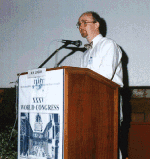 FATAL TRAFFIC ACCIDENTS INVOLVING METHAMPHETAMINE
FATAL TRAFFIC ACCIDENTS INVOLVING METHAMPHETAMINE
Logan B.K.
Washington State Toxicology Laboratory, 2203 Airport Way S., Seattle WA 98134, USA
Patterns of abuse for methamphetamine typically involve periods of extended administration lasting up to several days. During this time the user can be alert, focused and free from fatigue, however perception of abilities is altered, and seemingly inconsequential activities and events assume major significance for the user, and become distractions. The passage of time appears to proceed rapidly, and users often become impatient and aggressive. As the period of use proceeds, fatigue and sleep debt accumulates, and a progressive persecution ideation develops, during which the user becomes paranoid, and in some circumstances can develop a full blown toxic paranoid psychosis. Usually however, the user recognizes the onset of these effects, and the associated disphoria is one factor leading to the cessation of the spree. These effects are clearly deleterious to safe driving.
We have previously evaluated the epidemiology, symptomatology and driving behavior of drivers arrested for driving under the influence of methamphetamine, and found that their driving behavior is most commonly associated with drive-off-the-road type accidents consistent with withdrawal induced impairment, and high risk, high-speed driving, consistent with active stimulant intoxication.
In this study a second population of drivers has been evaluated - those drivers killed in traffic accidents who subsequently tested positive for methamphetamine. The demographics of this group (n=31) are evaluated, and found to be identical to those drivers arrested in terms of age, and sex, and patterns of alcohol and other drug use. Furthermore, the types of accidents involved are also identical, and the drivers are invariably the causing drivers. The significance of the blood concentrations of the drugs are further explored, and several case examples, including suicide by car crash, and death following police chases will be described. With the dramatic rise in the production and use of methamphetamine in the United States in the 1990s, drivers impaired from either the active intoxication phase, or withdrawal phase of methamphetamine use are a significant risk factor on the roads.
|